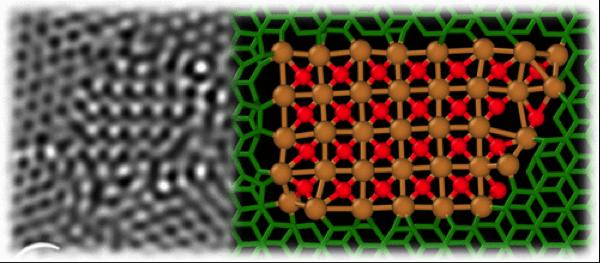A novel graphene-matrix-assisted stabilization method will help unique 2D materials to become a part

2D copper oxide material inside the two-layer graphene matrix Credit: Skoltech
The family of 2D materials has recently been joined by a new class, the monolayers of oxides and carbides of transition metals, which have been the subject of extensive theoretical and experimental research.
These new materials are of great interest to scientists due to their unusual rectangular atomic structure and chemical and physical properties, and in particular, a unique 2D rectangular copper oxide cell which does not exist in crystalline (3D) form, as opposed to most of the 2D materials, whether well-known or discovered lately, which have a lattice similar to that of their crystalline (3D) counterparts. The main hindrance for practical use of monolayers is their low stability.
A group of scientists from MISiS, the Institute of Biochemical Physics of RAS (IBCP), Skoltech, and the National Institute for Materials Science in Japan (NIMS) discovered 2D copper oxide materials with an unusual crystal structure inside the two-layer graphene matrix using experimental methods.
“Finding that a rectangular-lattice copper-oxide monolayer can be stable under given conditions is as important as showing how the binding of copper oxide and a graphene nanopore and formation of a common boundary can lead to creation of a small stable 2D copper oxide cluster with a rectangular lattice.
In contrast to the monolayer, the small copper oxide cluster's stability is driven to a large extent by the edge effects (boundaries) that lead to its distortion and, subsequently, destruction of the flat 2D structure.
Moreover, we demonstrated that binding bilayered graphene with pure copper, which never exists in the form of a flat cluster, makes the 2D metal layer more stable,” says Skoltech Senior Research Scientist Alexander Kvashnin.
The preferability of the copper oxide rectangular lattice forming in a bigraphene nanopore was confirmed by the calculations performed using the USPEX evolutionary algorithm developed by Professor at Skoltech and MIPT, Artem Oganov.
The studies of the physical properties of the stable 2D materials indicate that they are good candidates for spintronics applications.
Media Contact
All latest news from the category: Materials Sciences
Materials management deals with the research, development, manufacturing and processing of raw and industrial materials. Key aspects here are biological and medical issues, which play an increasingly important role in this field.
innovations-report offers in-depth articles related to the development and application of materials and the structure and properties of new materials.
Newest articles

High-energy-density aqueous battery based on halogen multi-electron transfer
Traditional non-aqueous lithium-ion batteries have a high energy density, but their safety is compromised due to the flammable organic electrolytes they utilize. Aqueous batteries use water as the solvent for…

First-ever combined heart pump and pig kidney transplant
…gives new hope to patient with terminal illness. Surgeons at NYU Langone Health performed the first-ever combined mechanical heart pump and gene-edited pig kidney transplant surgery in a 54-year-old woman…

Biophysics: Testing how well biomarkers work
LMU researchers have developed a method to determine how reliably target proteins can be labeled using super-resolution fluorescence microscopy. Modern microscopy techniques make it possible to examine the inner workings…





















